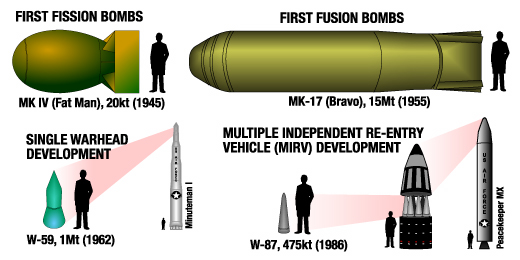W87 (nuclear weapon)
The W87 is a thermonuclear warhead of the United States .
history
The W87-0 is one of the youngest warheads in the US arsenal. It was for the Peacekeeper - intercontinental ballistic missile of the US Air Force from the Lawrence Livermore National Laboratory (LLNL) and Sandia developed. The aim was to develop a warhead with a relatively high explosive power and high accuracy for fighting "hard" targets such as missile silos. The basic design dates from the 1970s and could be tested with full explosive power before the Threshold Test Ban Treaty came into force in 1976. Concrete development work on the warhead began in February 1982. To qualify the W87 design, a total of 10 nuclear weapons tests were carried out on the Nevada Test Site (NTS) by mid-1983 , including tests prior to 1976. The Mk21 re-entry head for the W87 was made by AVCO Systems developed and tested in 3 nuclear weapon tests between 1983 and 1986 for its robustness against nuclear weapon effects. The Mk21 is heavier than the Mk12A for the Minuteman III's W78 , but has increased aiming accuracy at a lower cost. The first warhead was completed in April 1986. Mass production of the W87 began in July of that year and ended in December 1988. During this period, 525 warheads were built. Originally 1,000 were planned for 100 MX Peacekeeper missiles, but their number was reduced to 50 and with it the number of warheads required. Each MX could carry 11 warheads, but the SALT-2 treaty limited this to 10 warheads per missile. The first MX missiles with the W87 / Mk21 package entered service at Warren AFB on December 22, 1986 , and all 50 missiles with 500 warheads were operational by December 1988. The MX Peacekeeper was retired by 2005. It was decided that the W87 / Mk21 warheads would replace the W62 / Mk12 warheads on the Minuteman III . By 2008, all W62 / Mk12 were taken out of service and a W87 / Mk21 was installed on 200 rockets. Thus at the beginning of 2009 there were 200 W87 / Mk21 in active service with 10 warheads in reserve. For the Minuteman III, the W87 / Mk21 packages were modernized as part of the Safety Enhanced Reentry Vehicle program.
In November 1987 the development of the W87-1 for the Midgetman ICBM began. This warhead should have had an explosive force of 475 kt. However, development was stopped in July 1988 and the Midgetman was never stationed.
design
The W87-0 is a non-spherical, two-stage variant of the Teller-Ulam design with an explosive force of 300 kt . Its structure largely corresponds to that of the W88 warhead designed by the Los Alamos National Laboratory . The first stage of the weapon consists of a plutonium sphere filled with deuterium - tritium gas with a neutron reflector made of beryllium . The chemical explosive that implosions the core is LX-17 and PBX-9502. This polymer-bound explosive is insensitive to external influences. It is ignited at two points. The core of the first stage is fire-resistant and designed to withstand temperatures of 1000 ° C for several hours.
The second stage fusion material is a ball of lithium deuteride with 95% 6 Li and highly enriched uranium as a "spark plug" inside. The first and second stages are surrounded by a radiation channel filled with special plastic, the walls of which are made of depleted uranium. This is intended to focus the X-ray radiation generated when the first stage is ignited on the second stage in order to ignite it. The second stage is still surrounded by depleted uranium. In the case of the variant W87-1, which was stopped in development, this would have been replaced by highly enriched uranium, which would have increased the explosive power to 475 kt. The W87 was housed in a Mk21 re-entry head, which was largely identical to the Mk5 re-entry head of the W88. This has an aluminum structure coated with a graphite - epoxy composite material and a carbon fiber composite material as a heat shield. The warhead electronics are hardened against nuclear effects. The warhead is capable of detonation at low to high altitude as well as impact detonation.
Data
| Explosive device | W87-0 | W87-1 |
|---|---|---|
| Re-entry head | Mk21 | Mk21 |
| status | active stock | not put into service |
| operator | US Air Force | - |
| developer | LLNL , SNL | LLNL , SNL |
| Start of development | February 1982 | November 1987 |
| Start of production | April 1986 | - |
| End of production | December 1988 | - |
| number of items produced | 525 | 0 |
| design | Teller-ulam , two-tiered, not spherical | Teller-ulam , two-tiered, not spherical |
| Dimensions W87 / Mk21 | under 360 kg | under 360 kg |
| Length W88 / Mk5 | 1.75 m | 1.75 m |
| maximum diameter W88 / Mk5 | 0.55 m | 0.55 m |
| Explosive power | 300 kt | 475 kt |
| Carrier system | Peacekeeper (retired), Minuteman III | Midgetman (not commissioned) |
| Number per carrier | 10 (Peacekeeper), 1 (Minuteman III) | 1 |
| Scattering circle radius | about 100 m | - |

